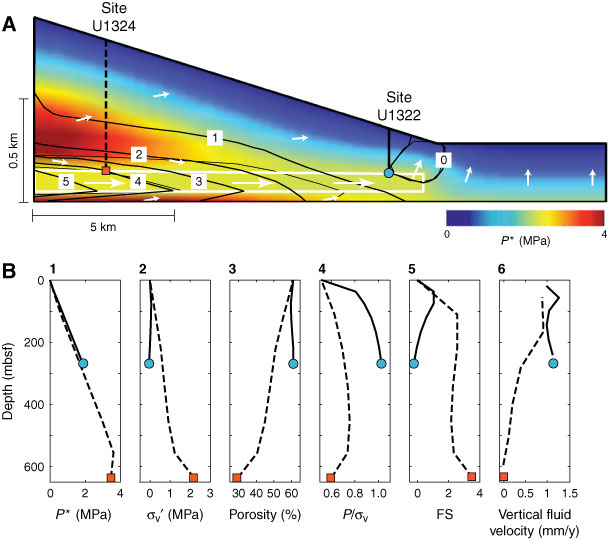Next Section |
Table of Contents
Figure F2. Flow-focusing model. A. Low permeability sediments are rapidly deposited on a high permeability aquifer (outlined in white). The sedimentation rate decreases from left to right, resulting in the final wedge-shaped geometry. Rapid sedimentation generates overpressures (P*; color contours) that are greatest on the left (red). Flow is driven laterally (left to right) along the aquifer and expelled at the toe of the slope where the aquifer ends (white arrows). The vertical effective stress (black contours) is lowest on the right. B. Predicted overpressure profiles where overburden is thick (Site U1324) and thin (Site U1322). (1) Overpressure at Site U1324 is greater than at Site U1322 for equivalent depths. (2) The vertical effective stress ( v') is much lower at Site U1322 than at Site U1324. (3) Porosities are much lower at Site U1322 than at Site U1324 for equivalent depths. (4) Pore pressures (P) equal the overburden stress (
v') is much lower at Site U1322 than at Site U1324. (3) Porosities are much lower at Site U1322 than at Site U1324 for equivalent depths. (4) Pore pressures (P) equal the overburden stress ( v) at Site U1322. (5) Infinite slope analyses (FS; relates the failure-driving stress to the available shear strength for shallow failures) predict unstable conditions (FS <1) for Site U1322. (6) Simulated vertical fluid velocity is higher at Site U1322 than at Site U1324. At Site U1324, we predict upward flow for most of the section but downward flow (velocity <0) just above the aquifer. Model parameters: low permeability mudstone kv < 5 x 10–8 m2 and kh < 5 x 10–16 m2; aquifer permeability kh = kv 5 x 10–14 m2; maximum sedimentation rate = 3.5 mm/y; minimum sedimentation rate = 0.8 mm/y.
v) at Site U1322. (5) Infinite slope analyses (FS; relates the failure-driving stress to the available shear strength for shallow failures) predict unstable conditions (FS <1) for Site U1322. (6) Simulated vertical fluid velocity is higher at Site U1322 than at Site U1324. At Site U1324, we predict upward flow for most of the section but downward flow (velocity <0) just above the aquifer. Model parameters: low permeability mudstone kv < 5 x 10–8 m2 and kh < 5 x 10–16 m2; aquifer permeability kh = kv 5 x 10–14 m2; maximum sedimentation rate = 3.5 mm/y; minimum sedimentation rate = 0.8 mm/y.
Next Section |
Table of Contents
 v') is much lower at Site U1322 than at Site U1324. (3) Porosities are much lower at Site U1322 than at Site U1324 for equivalent depths. (4) Pore pressures (P) equal the overburden stress (
v') is much lower at Site U1322 than at Site U1324. (3) Porosities are much lower at Site U1322 than at Site U1324 for equivalent depths. (4) Pore pressures (P) equal the overburden stress ( v) at Site U1322. (5) Infinite slope analyses (FS; relates the failure-driving stress to the available shear strength for shallow failures) predict unstable conditions (FS <1) for Site U1322. (6) Simulated vertical fluid velocity is higher at Site U1322 than at Site U1324. At Site U1324, we predict upward flow for most of the section but downward flow (velocity <0) just above the aquifer. Model parameters: low permeability mudstone kv < 5 x 10–8 m2 and kh < 5 x 10–16 m2; aquifer permeability kh = kv 5 x 10–14 m2; maximum sedimentation rate = 3.5 mm/y; minimum sedimentation rate = 0.8 mm/y.
v) at Site U1322. (5) Infinite slope analyses (FS; relates the failure-driving stress to the available shear strength for shallow failures) predict unstable conditions (FS <1) for Site U1322. (6) Simulated vertical fluid velocity is higher at Site U1322 than at Site U1324. At Site U1324, we predict upward flow for most of the section but downward flow (velocity <0) just above the aquifer. Model parameters: low permeability mudstone kv < 5 x 10–8 m2 and kh < 5 x 10–16 m2; aquifer permeability kh = kv 5 x 10–14 m2; maximum sedimentation rate = 3.5 mm/y; minimum sedimentation rate = 0.8 mm/y.
